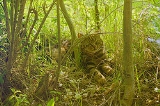
Cat coat genetics
Encyclopedia
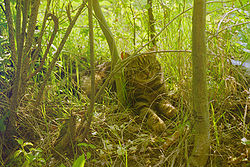
Genetics
Genetics , a discipline of biology, is the science of genes, heredity, and variation in living organisms....
of cat
Cat
The cat , also known as the domestic cat or housecat to distinguish it from other felids and felines, is a small, usually furry, domesticated, carnivorous mammal that is valued by humans for its companionship and for its ability to hunt vermin and household pests...
coat coloration, pattern, length, and texture is a complex subject, and many different gene
Gene
A gene is a molecular unit of heredity of a living organism. It is a name given to some stretches of DNA and RNA that code for a type of protein or for an RNA chain that has a function in the organism. Living beings depend on genes, as they specify all proteins and functional RNA chains...
s are involved.
Genes involved in albinism, dominant white, and white spotting
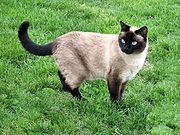
- The "C" gene codes for the enzyme tyrosinaseTyrosinaseTyrosinase also known as monophenol monooxygenase is an enzyme that catalyses the oxidation of phenols and is widespread in plants and animals...
, the first step in pigment production. Its recessive alleles determine whether a cat is a complete albinoAlbinismAlbinism is a congenital disorder characterized by the complete or partial absence of pigment in the skin, hair and eyes due to absence or defect of an enzyme involved in the production of melanin...
(pink-eyed) or a temperature sensitive albino. The temperature sensitive albino genotypes are cbcb Burmese (sepia), cscs Siamese (pointed), and cbcs Tonkinese (mink). The cscs gene can turn a cat's eyes blue due to a reduced number of melanocytes, affecting pigmentation of the eyes. If a cat has the dominant C allele, then the cat is non-albino and full pigment production occurs. - The white masking gene, W/w. The "W" gene prevents the normal replication and migration of pigment-producing cells during embryologic development. As a result, WW and Ww cats have a greatly reduced number of melanocytes and appear white, no matter what other color genes it may carry. Only a cat that is homozygous recessiveRecessiveIn genetics, the term "recessive gene" refers to an allele that causes a phenotype that is only seen in a homozygous genotype and never in a heterozygous genotype. Every person has two copies of every gene on autosomal chromosomes, one from mother and one from father...
(ww) will express normal pigmentation.Thus, W is epistaticEpistasisIn genetics, epistasis is the phenomenon where the effects of one gene are modified by one or several other genes, which are sometimes called modifier genes. The gene whose phenotype is expressed is called epistatic, while the phenotype altered or suppressed is called hypostatic...
to the other coat pigmentation genes. Some cats with the W allele of this gene are deaf and/or have depigmentation of the iris of one or both eyes, resulting in blue eye color. White cats are also more likely to get skin cancer. - The white spotting or piebald spotting gene, S/s, has variable expression, so that an SS cat often has more extensive white patching than an Ss cat. It is this gene that creates the familiar white blaze across the face, a white bib, tuxedo pattern, or dappled paws. A hypothetical Sb allele ("gloving gene") may cause the mittens in BirmanBirmanThe Birman is a domestic cat breed. Also called the "Sacred Cat of Burma", it is not to be confused with the Burmese, which is a separate and dissimilar breed. The Birman has medium-long hair, a pale colored body and darker points with deep blue eyes. Even though the cat is pointed, the paws have...
and SnowshoeSnowshoe (cat)The Snowshoe is a rare breed of cat originating in the United States of America in the 1960s. Snowshoes were first produced in Philadelphia when a Siamese breeder's cat gave birth to three kittens with white feet...
breeds. Some researchers believe that there are separate white spotting genes for distinct forms of white pattern, such as the white locket that some cats have on their neck or bellies.
Genes involved in orange, black, brown, and diluted colors
- The sex-linked red gene, O, determines if there will be red variations to fur color. This gene is located on the X chromosome. In cats with red variants of fur tone, phaeomelanin (red pigment) completely replaces eumelanin (black or brown pigment).
- Males have only one X chromosome, so only have one allele of this gene. O results in red variations, and o results in non-orange fur.
- Since females have two X chromosomes, they have two alleles of this gene. OO results in red toned fur, oo results in non-orange fur, and Oo results in a tortoiseshell catTortoiseshell catTortoiseshell describes a coat coloring found mostly in female cats. Cats of this color are mottled, with patches of orange or cream and chocolate, black or blue. They are sometimes called torties...
, in which some parts of the fur are red variants and others areas non-red.
A cat with Oo and white spotting genes is commonly called a calico. The reason for the patchwork effect in female cats heterozygous for the O gene (Oo) is X-inactivation
X-inactivation
X-inactivation is a process by which one of the two copies of the X chromosome present in female mammals is inactivated. The inactive X chromosome is silenced by packaging into transcriptionally inactive heterochromatin...
– one or the other X chromosome in every cell in the embryo is randomly inactivated (see Barr body
Barr body
A Barr body is the inactive X chromosome in a female somatic cell, rendered inactive in a process called lyonization, in those species in which sex is determined by the presence of the Y or W chromosome rather than the diploidy of the X or Z...
), and the gene in the other X chromosome is expressed.
- Rufous polygenes, as yet unidentified, can affect the richness of the orange/red gene's expression.
For a cat to be tortoiseshell, calico, or one of the variants such as blue-cream or chocolate tortoiseshell, the cat must simultaneously express two allele
Allele
An allele is one of two or more forms of a gene or a genetic locus . "Allel" is an abbreviation of allelomorph. Sometimes, different alleles can result in different observable phenotypic traits, such as different pigmentation...
s, O and o, which are located on the X chromosome
XY sex-determination system
The XY sex-determination system is the sex-determination system found in humans, most other mammals, some insects and some plants . In this system, females have two of the same kind of sex chromosome , and are called the homogametic sex. Males have two distinct sex chromosomes , and are called...
. Males normally cannot do this, as they have only one X chromosome, and therefore only one allele, and so calico cats are normally only female. Male tortoiseshell or calico cats occur only if they have chromosomal abnormalities such as the genotype XXY (in which case they are sterile
Sterility (physiology)
Sterility is the physiological inability to effect sexual reproduction in a living thing, members of whose kind have been produced sexually. The term may be used in reference to* types of organism, such as the mule, a sterile hybrid;...
), chromosomal mosaicism
Mosaic (genetics)
In genetic medicine, a mosaic or mosaicism denotes the presence of two populations of cells with different genotypes in one individual who has developed from a single fertilized egg...
(only portions of their cells have the genotype XXY, so these cats may be fertile), or chimericism
Chimera (genetics)
A chimera or chimaera is a single organism that is composed of two or more different populations of genetically distinct cells that originated from different zygotes involved in sexual reproduction. If the different cells have emerged from the same zygote, the organism is called a mosaic...
(a single individual formed from two fused embryos, at least one of which was male). Approximately 1 in 3,000 calico/tortoiseshell cats are male. Chimericism (which may result in fertile male cats) appears to be the most common mechanism.
- The browning gene B/b/bl codes for tyrosinase related protein-1, an enzyme involved in the metabolic pathway for eumelanin pigment production. Its dominant form, B, will produce black color. Recessive variants are b, producing brown (or chocolate), and bl producing light brown or cinnamon.
- Barrington Brown is a recessive browning gene that dilutes black to mahogany, brown to light brown and chocolate to pale coffee. It is different from the browning gene and has only been observed in laboratory cats.
- The Dense pigment gene, D/d, codes for melanophilinMelanophilinMelanophilin is a carrier protein which in humans is encoded by the MLPH gene. Several alternatively spliced transcript variants of this gene have been described, but the full-length nature of some of these variants has not been determined.- Function :...
, a protein involved in the transportation and deposition of pigment into a growing hair. When a cat has two of the recessive d alleles (Maltese dilution), black fur becomes "blue" (appearing gray), chocolate fur becomes "lilac" (appearing light brown), cinnamon fur becomes fawn, and orange fur becomes cream. - Dilution modifier gene, Dm, "caramelizes" the dilute colors as a dominant trait. The existence of this phenomenon as a discrete gene is a controversial subject among feline enthusiasts.
- A mutation at the extension locus E/e (the melanocortinMelanocortinThe melanocortins are a group of peptide hormones which include adrenocorticotropic hormone and the different forms of melanocyte-stimulating hormone . They can be synthetic . In humans they can be endogenously produced from proopiomelanocortin in the pituitary gland...
receptor) changes black pigment to amber or light amber. This phenomenon was first identified in Norwegian Forest CatsNorwegian Forest CatThe Norwegian Forest Cat is a breed of domestic cat native to Northern Europe, and adapted to a very cold climate, with top coat of glossy, long, water-shedding hairs, and a woolly undercoat for insulation...
. - A modifying factor has also been hypothesized in shaded silver and chinchilla PersiansPersian catThe Persian is a longhaired breed of cat characterized by its round face and shortened muzzle. Its name refers to Persia, the former name of Iran, where similar cats are found. Recognized by the cat fancy since the late 19th century, it was developed first by the English, and then mainly by...
whose fur turns pale golden in adulthood, due to low levels of phaeomelanin production. These cats resemble shaded or tipped goldens, but are genetically shaded or tipped silvers. This is probably related to the phenomenon known as "tarnishing" in silvers.
One can deduce that a grey male cat with a white bib and paws:
- has the o variant of the orange gene on its only X chromosome (because the grey color corresponds to black, not orange)
- has at least one S variant of the white Spotting gene (because it has the white bib and paws)
- has two w alleles (because it expresses a fur color)
- has the dominant B allele (because its fur color is a shade of black rather than brown)
- has two d (dilute) alleles (because its fur is grey, rather than black)
Genes involved in fur pattern and shading

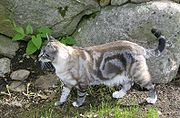
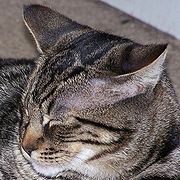
- The agouti geneAgouti geneThe Agouti gene is responsible for determining whether a mammal's coat is banded or of a solid color . The chief product of the Agouti gene is Agouti signalling peptide , but there are a number of alternative splice products....
, A/a which codes for agouti signaling protein. The dominant, wild-type A causes the agouti shift phenomenon which causes hairs to be black pigmented at the tips and orange pigmented at the roots (revealing the underlying tabby pattern), while the recessive non-agouti or "hypermelanistic" allele, a, prevents this shift in the pigmentation pathway. In its homozygous form, aa, this results in black pigment production throughout the growth cycle of the hair. Thus, the non-agouti genotype (aa) masks or hides the tabby pattern, although sometimes a suggestion of the underlying pattern can be seen (called "ghost striping"), especially in kittens. The O allele is also epistatic over the aa genotype. That is, the A to a mutation does not have a discernible effect on red or cream colored cats, resulting in these cats displaying tabby striping independent of their genotype at this locus. This explains why you can usually see the tabby pattern in the orange patches of non-agouti tortoiseshell cats, but not in the black or brown patches. - The primary tabby pattern gene, Mc/mc, sets the basic pattern of stripes that underlies the coat: the basic wild-type tabby gene, Mc, produces what is called a mackerel striped tabby (stripes look like thin fishbones and may break up into bars or spots); while a recessive mutant, mc, produces a blotched or classic tabby pattern (broad bands, whorls, and spirals of dark color on pale background usually with bulls-eye or oyster pattern on flank), common in Great Britain and in lands that were once part of the British Empire.
- Secondary tabby pattern genes such as Ta / ta, at which locus a dominant mutation produces an Abyssinian ticked or non-patterned agouti tabby, having virtually no stripes or bars. (This is one type of unpatterned tabby; the other type of unpatterned tabby is the shaded/chinchilla. See inhibited pigment gene, below.) The dominant ticked tabby allele masks all other tabby patterns.
- Other genes (pattern modifier genes) are theorized to be responsible for creating various type of spotting patterns, many of which are variations on a basic mackerel or classic pattern. There are also hypothetical factors which affect the timing and frequency of the agouti shift, affecting agouti band width and the number and quality of alternating bands of eumelanin and phaeomelanin on individual hairs.
Tabby cats (AA or Aa), normally have:
- M on forehead. (Visible in ticked tabby cats, but hard to discern in shaded silver/golden, and tipped cats)
- Thin pencil lines on face. (Visible in ticked tabby cats, but hard to discern in shaded silver/golden, and tipped cats)
- Black "eyeliner" appearance and white or pale fur around eyeliner.
- Pigmented lips and paws.
- A pink nose outlined in darker pigment
- Torso, leg, and tail banding. (Torso banding disappears in the ticked tabby.)
Most or all striping disappears in the chinchilla or shaded cat, but you can still identify the cat as a tabby from these other features.
- There is an interesting gene, not yet identified but believed to be related to the agouti gene, in the ChausieChausieA Chausie is a hybrid of the domestic cat and the Jungle Cat . Despite their wild appearance, they are domestic.- Breeding history :...
breed, that produces silver-tipped black fur similar to Abyssinian ticked fur. The "grizzled" phenomenon is purported to have been inherited from the hybridization of domestic cats to Jungle Cats. - The inhibited pigment gene, I/i. The dominant allele (I) produces tipped hairs that are fully colored only at the tip and have a white base. This allele appears to interact with other genes to produce various degrees of tipping, ranging from deeply tipped silver tabby to lightly tipped shaded silver and chinchilla silver. The inhibitor gene interacts with the non-agouti genotype (I-aa) to produce the color known as smoke. The homozygous recessive genotype when combined with the agouti gene (iiA-), produces tabby coloration, which can vary along a spectrum ranging from a deeply patterned brown tabby, to a lighter "golden tabby", to the very lightly colored shaded or chinchilla golden colors. Orange cats with the inhibitor gene (I-O-) are commonly called "cameo".
The genetics involved in producing the ideal tabby, tipped, shaded, or smoke cat is complex. Not only are there many interacting genes, but genes sometimes do not express themselves fully, or conflict with one another. For example, the melanin inhibitor gene sometimes does a poor job blocking pigment, resulting in an excessively gray undercoat, or in tarnishing (yellowish or rusty fur). Likewise, poorly-expressed non-agouti or over-expression of melanin inhibitor will cause a pale, washed out black smoke. Various polygenes (sets of related genes), epigenetic factors, or modifier genes, as yet unidentified, are believed to result in different phenotypes of coloration, some deemed more desirable than others by fanciers.
Here are the genetic influences on tipped or shaded cats:
- Agouti gene.
- Tabby pattern genes (such as Ta masking the tabby pattern).
- Silver or melanin inhibitor gene.
- Factors affecting the number and width of bands of color on each hair (such as the hypothetical wide band gene).
- Factors affecting the amount and quality of eumelanin and/or phaeomelanin pigment expression (such as theorized rufousing factors)
- Genes causing sparkling appearance (such as glitter in the Bengal, satin in the Tennessee Rex, grizzle in the Chausie).
- Factors to clear up residual striping (hypothetical Chaos, Confusion, Unconfused, Erase, and Roan factors).
Genes involved in fur length and texture
Cat fur length is governed by the Long hair gene in which the dominant form, LDomestic shorthaired cat
A domestic shorthaired cat is a cat fancy term used to describe a shorthaired cat that does not have a pedigree or belong to a recognized cat breed...
, codes for short hair, and the recessive l
Domestic longhaired cat
A domestic longhaired cat is a cat fancy term used to describe a cat with medium or long fur that is not a pedigreed member of a recognized breed. Domestic longhairs come in all the standard cat colours including tabby, tortie, bi-colored, smoke etc...
codes for long hair. In the longhaired cat, the transition from anagen (hair growth) to catagen (cessation of hair growth) is delayed due to this mutation. A rare recessive shorthair gene has been observed in some lines of Persian cat (silvers) where two longhaired parents have produced shorthaired offspring.
There have been many genes identified that result in unusual cat fur. These genes were discovered in random-bred cats and selected for. Some of the genes are in danger of going extinct because the cats are not sold beyond the region where the mutation originated or there is simply not enough demand for cats expressing the mutation.
In many breeds, coat gene mutations are unwelcome. An example is the rex allele which appeared in Maine Coons in the early 1990s. Rexes appeared in America, Germany and the UK, where one breeder caused consternation by calling them "Maine Waves". Two UK breeders did test mating which indicated that this was probably a new rex mutation and that it was recessive. The density of the hair was similar to normally coated Maine Coons, but consisted only of down type hairs with a normal down type helical curl, which varied as in normal down hairs. Whiskers were more curved, but not curly. Maine Coons do not have awn hairs, and after moulting, the rexes had a very thin coat.
There are various genes producing curly coated or "rex" cats. New types of rex pop up spontaneously in random-bred cats now and then. Here are some of the rex genes that breeders have selected for:
- r = Cornish RexCornish RexA Cornish Rex is a breed of domestic cat. The Cornish Rex has no hair except for down. Most breeds of cat have three different types of hair in their coats: the outer fur or "guard hairs", which is about 5 cm long in shorthairs and 10cm+ long in longhairs; a middle layer called the "awn hair";...
, recessive. - gr (provisional) = German RexGerman RexGerman Rex is a breed of domestic cat. They are a medium sized breed with slender legs of a medium length. The head is round with well-developed cheeks and large, open ears. The eyes are of medium size in colours related to the coat colour. The coat is silky and short with a tendency to curl. The...
, recessive. Same locusLocus (genetics)In the fields of genetics and genetic computation, a locus is the specific location of a gene or DNA sequence on a chromosome. A variant of the DNA sequence at a given locus is called an allele. The ordered list of loci known for a particular genome is called a genetic map...
as Cornish, but proposed as a different alleleAlleleAn allele is one of two or more forms of a gene or a genetic locus . "Allel" is an abbreviation of allelomorph. Sometimes, different alleles can result in different observable phenotypic traits, such as different pigmentation...
. However, most breeders consider the German Rex to have r/r genotype. - re = Devon RexDevon RexThe Devon Rex is a breed of intelligent, short-haired cat that emerged in England during the 1960s. They are known for their slender bodies, wavy coat, and large ears, similar to the Cornish Rex.-Discovery and relations:...
, recessive. - ro = Oregon RexOregon RexThe Oregon Rex was one of several breeds of Rex cats which in the mid-20th-century occurred from spontaneous genetic mutation.After its acknowledgment as a separate breed, it enjoyed a short time of popularity among cat breeders in the United States...
(extinct), recessive. - Se = Selkirk RexSelkirk RexThe Selkirk Rex is a breed of cat with highly curled hair, including the whiskers . It is distinct from all other Rex breeds. Unlike the Devon Rex and Cornish Rex, the hair is of normal length and not partly missing, and there are longhair and shorthair varieties...
, dominant although sometimes described as an incomplete dominant because the three possible allele parings relate to three different phenotypes: heterozygous cats (Sese) may have a fuller coat that is preferred in the show ring, while homozygous cats (SeSe) may have a tighter curl and less coat volume. (sese type cats have a normal coat.) This phenomenon may also coloquially be referred to as additive dominance. - Lp (provisional) = LaPermLaPermThe LaPerm is a recognized breed of cat. A LaPerm's fur is curly , with the tightest curls being on the belly, throat and base of the ears. LaPerms come in many colors and patterns. LaPerms generally have a very affectionate personality....
, dominant: Lp/lp and Lp/Lp individuals have the same phenotype.
There are also genes for hairlessness:
- h = French hairless cat, recessive.
- hd = British hairless cat, recessive.
- Hp = Russian Donskoy and PeterbaldPeterbald- Appearance :Peterbalds have an elegantly slim graceful and muscular build. They have a narrow and long head with a straight profile, almond-shaped eyes, wedge-shaped muzzle, and big set-apart ears. They have a long whippy tail, webbed feet and oval paws that allow them to grasp objects and open...
, dominant. - hr = Canadian Sphynx catSphynx (cat)The Sphynx is a rare breed of cat known for its lack of a coat.The contemporary breed of Sphynx started in 1966, in Roncesvalles, Toronto when a hairless kitten named Prune was born. The kitten was mated with its mother , which produced one more naked kitten...
, recessive.
Some rex cats are prone to temporary hairlessness, known as baldness, during moulting.
Here are a few other genes resulting in unusual fur:
- The Wh gene (dominant, possibly incomplete) results in WirehairAmerican WirehairThe American Wirehair is a breed of domestic cat originating in upstate New York. As of 2003, though the breed is well-known, it is ranked as the most rare of the 41 Cat Fancier's Association breeds, with only 22 registered, down from 39 in 2002.-History:...
cats. They have bent or crooked hair producing springy, crinkled fur. - A hypothetical Yuc gene, or York ChocolateYork Chocolate CatThe York Chocolate Cat is a new American breed of show cat, with a long, fluffy coat and a tapered tail and most of them are chocolate. The first part of its name is taken from New York state, where it was bred in 1983...
undercoat gene, results in cats with no undercoat. However, the proportional relationship between guardGuard hairGuard hairs are the longest, coarsest hairs in a mammal's coat, forming the topcoat . They taper to a point and protect the undercoat from the elements. They are often water repellent and stick out above the rest of the coat...
, awnAwn hairAwn hairs are the intermediate hairs in a mammal's coat. They are shorter than the guard hairs and longer than the down hairs. They help with insulation and protect the down hairs underneath. Most of the visible coat is made of this kind of hair....
, and down hairDown hairDown hairs, also called the ground hairs, are the very fine, fluffy hairs closest to the skin on some mammals. The hairs are short and crimped, which makes them highly efficient for trapping air and insulating the animal....
production varies greatly between all breeds. - A recessive autosomal gene for Onion hair which causes roughness and swelling on the hairs. The swelling is due to enlargement of the inner core of medulla cells.
- A recessive autosomal gene spf for sparse fur. As well as sparse coat, the hairs are thin, straggly and contorted and there is brown exudate around the eyes and nose and on the chest and stomach. A similar condition is linked to Ornithine Transcarbamylase DeficiencyOrnithine transcarbamylase deficiencyOrnithine transcarbamylase deficiency , the most common of the urea cycle disorders, is a rare metabolic disorder, occurring in one out of every 80,000 births...
in mice.
See also
- Bicolor catBicolor catA bicolor cat has white fur combined with fur of some other color, for example black or tabby. There are various patterns of bicolor cat. These range from Van pattern through to solid color with a throat locket...
- Tortoiseshell catTortoiseshell catTortoiseshell describes a coat coloring found mostly in female cats. Cats of this color are mottled, with patches of orange or cream and chocolate, black or blue. They are sometimes called torties...
- Point (coat color)Point (coat color)Point coloration refers to animal coat coloration with a pale body and relatively darker extremities, i.e. the face, ears, feet, tail, and scrotum...
- Barr bodyBarr bodyA Barr body is the inactive X chromosome in a female somatic cell, rendered inactive in a process called lyonization, in those species in which sex is determined by the presence of the Y or W chromosome rather than the diploidy of the X or Z...
- Tabby catTabby catA tabby is any cat that has a distinctive coat that features stripes, dots, lines or swirling patterns, usually together with an "M" mark on its forehead. Tabbies are sometimes erroneously assumed to be a cat breed. In fact, the tabby pattern is found in many breeds of cat, as well as among the...
- Maltese catMaltese catMaltese cat is a name that is often given to any cat whose fur is either completely, or primarily, gray or blue and is of indeterminate breed. Many cats with such colouration are supposedly present on the island of Malta, which may have given rise to the use of the adjective in this context...
- Deaf white catDeaf white catSome white cats suffer from congenital deafness caused by degeneration of the inner ear. This condition is associated with blue irises. In white cats with mixed-coloured eyes , it has been found that deafness is more likely to affect the ear on the blue-eyed side...

